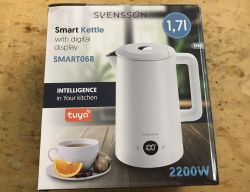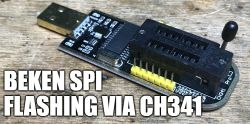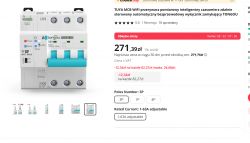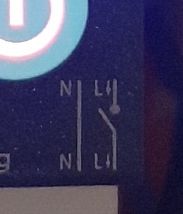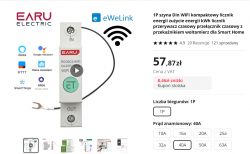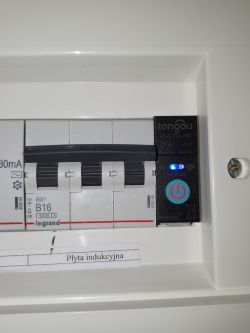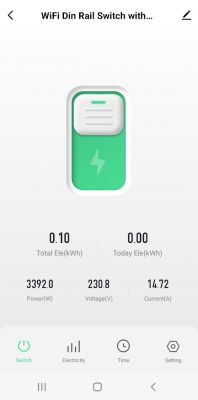Hello
By way of introduction: a few months ago I was looking for an induction hob with wifi. It was basically just about being able to see if the hob was working at all (it's on, drawing electricity) and possibly remotely switch it off. In the end, I ended up buying a classic hob, without any wifi, tie-dye, but quite ergonomic, user-friendly. More about my "investigation into the truth" in THIS topic
I am, however, slowly returning to the subject of the possibility of remote control operation/shutdown. If anyone asked why and what it is for - it was explained in that topic.
I am planning to implement in the switchgear. I would like to keep it relatively simple and at a relatively low cost. Space is also limited. The board is connected to a 3-phase network. Standard, that is, in fact, to two phases (2x230V, L,N), the oven and microwave are powered from the third.
I have found single-phase wifi modules with current/power measurement and shutdown. Of course you will need two. E.g. such:
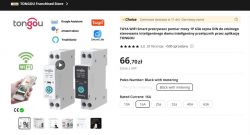
https://pl.aliexpress.com/item/1005005625395611.html
In principle, judging from the description, these are "230V sockets with wifi", only that they are DIN rail mounted. However, I have doubts about the connection and "will it even work", which I have shown in the diagram below:
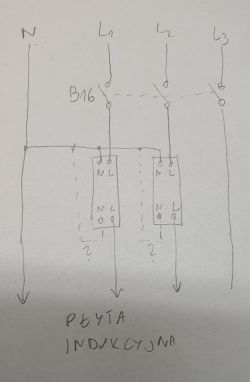
As you can see, the power "enters" via a B16 three-phase fuse. Then two phases to the board via the modules, each input "at the top" connected to the correct L and N. And here is the dilemma - the N "goes" towards the kitchen, past the fuse, as one common wire.
The L output "at the bottom" of the module - known, to the board.
But what about the N output on the module? Leave it unconnected? What about current/load measurement then? Will it work? (presumably depending on where the measuring shunt is located - "in L or in N"?) Or also connect to the neutral wire running to the board? That is, de facto short circuit to the N connected to the input ("at the top") of the module, as I have drawn a line with a question mark?
As option 2: I also searched on the internet for a three-phase wifi fuse/switch/monitor with which I could replace the current B16. And yes, there are such "in nature", e.g.:
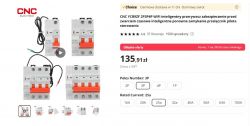
https://pl.aliexpress.com/item/1005005243212896.html
but unfortunately without monitoring function. Only "off/on". With measurement I have not been able to find.
Beyond that a three-phase switch will also cut off my oven+microwave, watches again to set Although I assume the situation of the need for a remote disconnection will be very sporadic (hopefully never), so you can get over it.
Although I assume the situation of the need for a remote disconnection will be very sporadic (hopefully never), so you can get over it.
I have also found energy measuring devices with current transformers, based on PZEM004T modules. You can quite inexpensively get pre-assembled 3-phase "folders" with wifi. The advantage would be that I could then do energy/load monitoring on all phases, for the whole house network, not just the induction alone. I think I would be able to tell if the hob is actually on, despite the possible operation of other appliances. Also, virtually no interference with the 'current' installation, just a matter of connecting the power supply. On the other hand, a possible remote disconnection of the hob will take care of the above-mentioned 3-phase switch with wifi. Or give up on switching off and stick to the load monitoring option (option 3). The snag is that the "folding box" almost certainly won't fit into the switchboard (although I'd have to measure again - I'm currently away from the property). I can still fit the two modules mentioned earlier somehow. I know - there are still devices of the type Zamel MEW-01 , but ceeeeeena...
Are there any other ideas, suggestions, proposals for devices?
Greetings.
By way of introduction: a few months ago I was looking for an induction hob with wifi. It was basically just about being able to see if the hob was working at all (it's on, drawing electricity) and possibly remotely switch it off. In the end, I ended up buying a classic hob, without any wifi, tie-dye, but quite ergonomic, user-friendly. More about my "investigation into the truth" in THIS topic
I am, however, slowly returning to the subject of the possibility of remote control operation/shutdown. If anyone asked why and what it is for - it was explained in that topic.
I am planning to implement in the switchgear. I would like to keep it relatively simple and at a relatively low cost. Space is also limited. The board is connected to a 3-phase network. Standard, that is, in fact, to two phases (2x230V, L,N), the oven and microwave are powered from the third.
I have found single-phase wifi modules with current/power measurement and shutdown. Of course you will need two. E.g. such:

https://pl.aliexpress.com/item/1005005625395611.html
In principle, judging from the description, these are "230V sockets with wifi", only that they are DIN rail mounted. However, I have doubts about the connection and "will it even work", which I have shown in the diagram below:

As you can see, the power "enters" via a B16 three-phase fuse. Then two phases to the board via the modules, each input "at the top" connected to the correct L and N. And here is the dilemma - the N "goes" towards the kitchen, past the fuse, as one common wire.
The L output "at the bottom" of the module - known, to the board.
But what about the N output on the module? Leave it unconnected? What about current/load measurement then? Will it work? (presumably depending on where the measuring shunt is located - "in L or in N"?) Or also connect to the neutral wire running to the board? That is, de facto short circuit to the N connected to the input ("at the top") of the module, as I have drawn a line with a question mark?
As option 2: I also searched on the internet for a three-phase wifi fuse/switch/monitor with which I could replace the current B16. And yes, there are such "in nature", e.g.:

https://pl.aliexpress.com/item/1005005243212896.html
but unfortunately without monitoring function. Only "off/on". With measurement I have not been able to find.
Beyond that a three-phase switch will also cut off my oven+microwave, watches again to set
I have also found energy measuring devices with current transformers, based on PZEM004T modules. You can quite inexpensively get pre-assembled 3-phase "folders" with wifi. The advantage would be that I could then do energy/load monitoring on all phases, for the whole house network, not just the induction alone. I think I would be able to tell if the hob is actually on, despite the possible operation of other appliances. Also, virtually no interference with the 'current' installation, just a matter of connecting the power supply. On the other hand, a possible remote disconnection of the hob will take care of the above-mentioned 3-phase switch with wifi. Or give up on switching off and stick to the load monitoring option (option 3). The snag is that the "folding box" almost certainly won't fit into the switchboard (although I'd have to measure again - I'm currently away from the property). I can still fit the two modules mentioned earlier somehow. I know - there are still devices of the type Zamel MEW-01 , but ceeeeeena...
Are there any other ideas, suggestions, proposals for devices?
Greetings.



